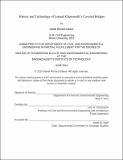| dc.contributor.advisor | John A. Ochsendorf. | en_US |
| dc.contributor.author | Gleave, Daniel Richard | en_US |
| dc.contributor.other | Massachusetts Institute of Technology. Department of Civil and Environmental Engineering. | en_US |
| dc.coverage.spatial | n-us-wv | en_US |
| dc.date.accessioned | 2014-09-19T19:37:21Z | |
| dc.date.available | 2014-09-19T19:37:21Z | |
| dc.date.copyright | 2014 | en_US |
| dc.date.issued | 2014 | en_US |
| dc.identifier.uri | http://hdl.handle.net/1721.1/89849 | |
| dc.description | Thesis: M. Eng., Massachusetts Institute of Technology, Department of Civil and Environmental Engineering, 2014. | en_US |
| dc.description | This electronic version was submitted by the student author. The certified thesis is available in the Institute Archives and Special Collections. | en_US |
| dc.description | Cataloged from student-submitted PDF version of thesis. | en_US |
| dc.description | Includes bibliographical references (pages 100-102). | en_US |
| dc.description.abstract | Lemuel Chenoweth was a carpenter and bridge builder who played a key role in the development of the infrastructure of antebellum Virginia. Theodore Burr and Lewis Wernwag are among the designers who influenced the structure and construction of his bridges, two of which are currently standing in West Virginia. The timber covered bridge at Beverly is one of Chenoweth's key creations that have been lost, which was at the time located on a key turnpike running through the county seat. The first goal of the following study is to establish the geometry of the Beverly Bridge. To do this, historical photographs of the construction and the finished bridge were studied. Salvaged timbers from the bridge were observed to establish the cross-sectional dimensions and species of the wood. Finally, surveys of Chenoweth's existing bridges were performed to determine the probable joinery and truss dimensions. A second goal is to perform a simplified and finite element analysis of the bridge in order to determine its performance under modern vehicle loading. A third goal is to determine the feasibility of reconstruction of the bridge. The Beverly Bridge is compared to other existing timber covered bridges of a similar span and type in order to prove that similar bridges can withstand modern loads adequately. Modifications that may be made to the bridge are then discussed, covering both structural and nonstructural considerations. Finally, the cost of reconstructing the bridge today is assessed. | en_US |
| dc.description.statementofresponsibility | by Daniel Richard Gleave. | en_US |
| dc.format.extent | 102 pages | en_US |
| dc.language.iso | eng | en_US |
| dc.publisher | Massachusetts Institute of Technology | en_US |
| dc.rights | M.I.T. theses are protected by copyright. They may be viewed from this source for any purpose, but reproduction or distribution in any format is prohibited without written permission. See provided URL for inquiries about permission. | en_US |
| dc.rights.uri | http://dspace.mit.edu/handle/1721.1/7582 | en_US |
| dc.subject | Civil and Environmental Engineering. | en_US |
| dc.title | History and technology of Lemuel Chenoweth's covered bridges | en_US |
| dc.type | Thesis | en_US |
| dc.description.degree | M. Eng. | en_US |
| dc.contributor.department | Massachusetts Institute of Technology. Department of Civil and Environmental Engineering | |
| dc.identifier.oclc | 890135883 | en_US |
